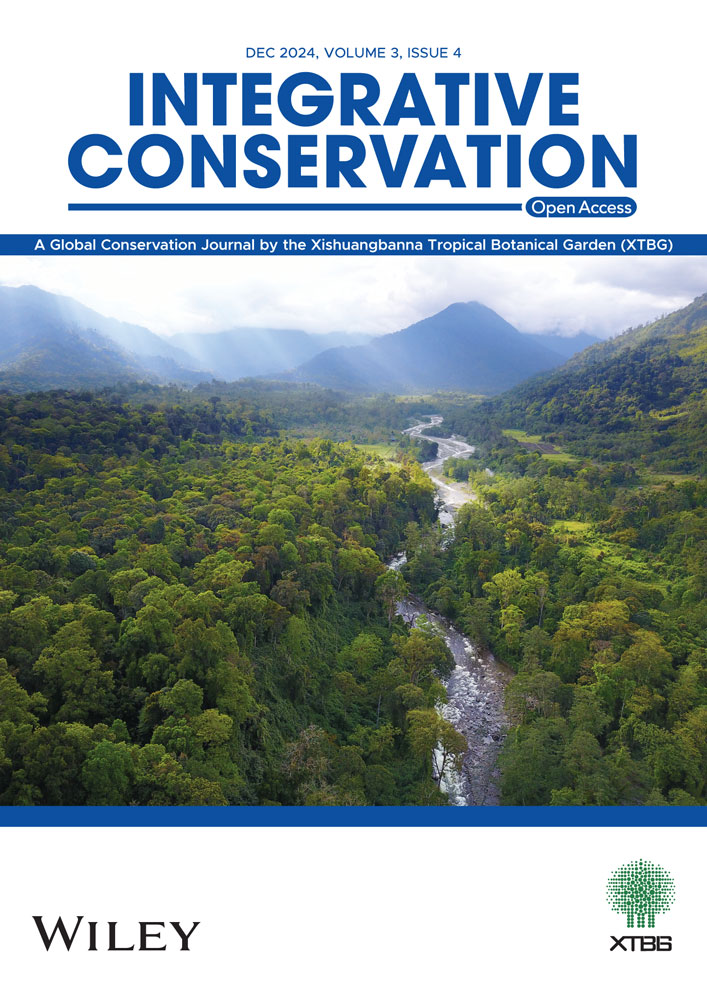Pollination research in India: Current status, future vision and conservation implications
印度的传粉研究现状、愿景与保护启示
Arjun Adit and Vineet Kumar Singh contributed equally to this study.
Editor-in-Chief & Handling Editor: Ahimsa Campos-Arceiz
Abstract
enPollination is a dynamic ecological interaction, that has evolved to promote the survival and reproductive success of flowering plants and their pollinators. Human-induced environmental changes in recent decades have reduced the density and diversity of pollinators and have resulted in a global pollinator crisis. Western countries have realized this problem since the beginning of this century and extensive research has been going on to study pollinators and pollination in both wild and crop species. To mitigate the crisis, considerable success has been achieved in these countries. In India, investigations on plant-pollinator interaction, as well as global pollinator-crisis have received very little attention in spite of its rich biodiversity. So far, the contribution from the Indian region towards pollination biology is merely 5% of the world. This review summarizes limited data available on pollination ecology, analyses possible reasons for this situation, highlights the importance of initiating serious studies on pollinators and pollination and provides a roadmap. It is concluded that a collaborative initiative involving the scientific community, society and policymakers is a prerequisite to achieve the objectives of biodiversity conservation and crop productivity in the country.
摘要
zh传粉是一种动态的生态相互作用,在演化过程中,它有利于开花植物及其传粉动物的生存和成功繁殖。近几十年来,人类引发的环境变化使传粉动物的密度和多样性下降,进而导致了全球性的传粉动物危机。西方国家从21世纪初就意识到这一问题,并针对野生物种和农作物的传粉者及其传粉情况开展了大量研究,从而这些国家在缓解该危机方面已经取得了很大的成功。然而在印度,虽然其生物多样性丰富,但对植物-传粉者相互作用及全球传粉动物危机的研究却极少得到关注。截至目前,印度对传粉生物学的贡献仅占全球的5%。本综述对现有的传粉生态学有限数据进行了总结,分析了造成这种情况的可能因素,强调了深入开展传粉动物及传粉情况研究的重要性,并提出了开展传粉研究的路线图。最后,本综述得出结论:科学界、社会和政策制定者携手合作是实现印度生物多样性保护和农作物生产力目标的前提。【审阅:崔晴岚】
Plain language summary
enPollination is an indispensable ecosystem service for the perpetuation of flowering plants around the globe. A regional perturbation in the service, especially in the biodiversity-rich regions, can have a cascading impact at the global level. In India, a species-rich region, though attempts have been made to study pollination ecology, these are either species centric or, unlike many developed countries, do not produce enough quantitative data for long-term assessment. Appallingly, contribution towards pollination research from the Indian region has been somehow lagging. This review makes an attempt to look into the issue and proposes ways to fill the gaps in knowledge. We also propose a roadmap for practitioners including researchers and policy makers that will be useful in conserving biodiversity and sustaining food security in the region.
简明语言摘要
zh传粉对于全球有花植物的繁衍来说是一项不可或缺的生态系统服务。这项服务若在某个区域出现扰动,尤其是在生物多样性丰富的区域,可能会在全球层面产生连锁影响。印度是一个物种丰富的地区,尽管已经有学者尝试开展传粉生态学研究,但这些研究要么以物种为中心,要么收集数据方法与许多发达国家不同,无法提供足够的定量数据用于长期评估。令人担忧的是,印度在传粉研究方面的贡献在一定程度上较为滞后。本综述旨在探究这一问题,并提出弥补知识空白的方法。我们还为研究人员和政策制定者在内的从业者拟定了一个路线图,这一路线图将有助于保护该地区的生物多样性并维持粮食安全。
Practitioner points
en
-
India is a mega biodiverse country with four biodiversity hotspots, yet the region has not contributed proportionally towards pollination research, which is imperative not just for biodiversity conservation but also for food security.
-
Pollination research in India is paramount in the present age where erratic weather conditions manifesting due to climate change are clearly perceivable.
-
Comprehensive and relevant data from mega biodiverse countries such as India is needed to help policymakers sustainably manage food security, prevent pollinator decline and protect plant biodiversity.
实践者要点
zh
-
印度是一个生物多样性极为丰富的国家,其境内有四大生物多样性热点地区。然而,该国在传粉研究方面的贡献与其生物多样性的丰富程度并不相衬,要知道传粉研究对于生物多样性保护和粮食安全都至关重要。
-
如今,气候变化引发的极端天气现象日益 增加,在这种情况下,印度的开展传粉研究就显得尤为重要。
-
像印度这样生物多样性极为丰富的国家,需要提供全面且相关的数据,这样才能帮助政策制定者可持续地管理粮食安全,防止传粉者数量减少,进而保护植物多样性。
1 INTRODUCTION
Pollination, the process of transferring pollen grains from the anther to the stigma, is a prerequisite for fruit and seed formation. This ecological process plays a vital role in sustaining wild flowering plants and enhancing crop productivity. Pollination can be facilitated by water, wind, or animals, with animals being the most reliable vectors responsible for pollinating almost 87.5% of the world's flowering plants (Larson and Barrett, 2000; Nabhan and Buchmann, 1997; Ollerton et al., 2011). This mutualistic interaction between plants and animals is crucial for sustaining global food security, as approximately 75% of crop species rely on animal pollinators, accounting for around 35% of our total food production (Aizen et al., 2019; Klein et al., 2007). Many cash crops, such as coffee, cocoa, soybeans, palm oil, avocado, pulses, fruits and vegetables, heavily depend on animal-mediated pollination (Khalifa et al., 2021). Moreover, pollinators contribute to achieving at least 7 of the 17 Sustainable Development Goals (SDGs), while 11 of the 17 SDGs directly impact pollinators (Patel et al., 2021).
India, an agrarian economy, relies heavily on pollinators for food security and the livelihoods of farmers (Thomson Jacob et al., 2020). To boost food crop production within the land available, it has been suggested that more than 200 million bee colonies should be used for pollination services (Abrol, 2023). The employment of domesticated bees was also part of the ‘Sweet Revolution’ initiative in 2016, aimed at doubling farmers' incomes. A significant endeavour in this regard is the National Mission for Sustainable Agriculture (NMSA, https://nmsa.dac.gov.in/), which strives to enhance the efficiency and productivity of India's agricultural system by promoting the practice of scientific beekeeping (https://nmsa.dac.gov.in/). Nonetheless, there is a lack of appropriate legislation, policies and funding for research on the assessment, monitoring and conservation of wild pollinators in India. Moreover, there has been limited emphasis placed on pollinator and pollination studies.
Unfortunately, the importance of wild pollinators, which contribute most to pollination, is often underestimated (Garibaldi et al., 2013). In 2016, the Intergovernmental Science-Policy Platform on Biodiversity and Ecosystem Services (IPBES, 2016) reported a 37% reduction in bee species and a 31% decline in butterfly populations, carrying noteworthy implications. This situation significantly impacts more than three-quarters of global food crops (Díaz et al., 2019; IPBES, 2016; Marselle et al., 2021).
To combat the threat of pollinator loss, international efforts such as the International Pollinator Initiative (IPI) under the Convention on Biodiversity, along with various continental, national and regional programmes, have been launched to conserve pollinators (IPBES, 2016). However, repeated failures to meet consecutive decadal sustainable targets underscore the urgent need for inclusive actions that consider local challenges and implement targeted policies to safeguard pollinators.
Pollination ecology is pivotal for addressing the gaps in our understanding of pollinator behaviour, diversity and the factors influencing species loss and population restorations (Mayer et al., 2011). It also plays an indirect role in shaping strategies and policies for sustainable development. A lack of knowledge about the natural history of plants in the Indian subcontinent has hindered the development of holistic strategies for maximizing agricultural output and conserving plant-pollinator interactions. The research community in India has largely overlooked this crisis, with only a small number of research groups currently focused on pollination biology (Basu et al., 2011; Karmakar, 2017; Shivanna et al., 2020). While there has been some recent growth in the number of researchers in this field, substantial potential remains untapped, especially considering India's abundant biodiversity.
This review aims to (i) quantify India's research contributions to pollination biology by analyzing relevant literature available on the Web of Science from the past three decades (1990–2023), (ii) assess the economic value of pollinator services for several major pollinator-dependent crops in India and (iii) identify critical gaps for future research endeavours.
2 METHODOLOGY
2.1 Literature survey
To ascertain the distribution of research articles on pollination ecology, in February 2023, we surveyed peer-reviewed and Scopus-indexed articles from the Web of Science database, covering publications from 1990 to early 2023. To compare India's scientific contributions in pollination biology with global trends, we conducted a comprehensive literature search using the terms ‘Pollination Biology’ and ‘Pollination Biology AND India’ in article titles, keywords and abstracts. We then carefully selected papers that specifically addressed pollination studies. After eliminating irrelevant articles from our analysis, we organized the collected data chronologically. The screening process, exclusion criteria and final data set adheres to the Preferred Reporting Items for Systematic Reviews and Meta-Analyses (PRISMA) guidelines (Page et al., 2021; Supporting Information S1: Figure 1). We then categorized these publications based on the nature and type of plants involved, such as crops (‘Pollination biology AND crops’), non-crops (‘Pollination biology NOT crops’), medicinal plants (‘Pollination biology AND medicinal plants’), endemic species (“Pollination biology AND endemic plants’), threatened plant species (‘Pollination biology AND threatened plants’) and trees (‘Pollination biology AND trees’). We compared these categories for articles published in India against the overall pool of publications. Additionally, we identified studies addressing different aspects of pollination and plant reproductive fitness, encompassing topics such as breeding systems, mating systems, inbreeding depression, self-incompatibility, pollination limitation and pollinator decline. We also organized the studies year by year, categorizing them by various pollination syndromes such as wind, bee, fly, moth, bird, butterfly and bat pollination.
2.2 Economic potential of pollination
To determine the economic value of pollination, six economically important and pollinator-dependent crops were selected: Cajanus cajan (pigeonpea), Cicer arietinum (chickpea), Brassica napus (rapeseed), Helianthus annuus (sunflower), Gossypium spp. (cotton), and Theobroma cacao (cacao). These were chosen because (i) these are all pollinator-dependent, (ii) they represent all plant forms, that is, herbs/shrubs/trees, (iii) these are cash crops that have high minimum support price for farmers set by the government, and (iv) these crops are popular in the domestic market (https://www.indiastat.com/). The production value method was used to assess the economic value of pollinator services (Winfree et al., 2011). This method applies the formula EVp = D × P × Y, where EVp represents the Economic Value of the pollinator. In this formula, D signifies a crop's dependency on pollinators, P represents the crop's economic value in terms of the minimum support price (MSP) and Y corresponds to the crop's yield in kilograms per hectare. The pollinator dependency rate data employed in this calculation was sourced from Gallai et al. (2009) and Klein et al. (2007). Data on crop yield and prices in India (2012–2022) were obtained from the Ministry of Agriculture and Farmers Welfare, a government entity and Indiastat (https://www.indiastat.com/), an extensive e-resource providing socioeconomic statistical information. Year-wise Minimum Support Prices (MSP) for various crops were collected from the Farmers Portal (farmer. gov. in) and the Directorate of Cashewnut & Cocoa Development (DCCD). Information on the categories and usage of chemical and bio-pesticides from 2014 to 2021 was also sourced from Indiastats.
Data visualization was done using the ggplot2 package in R ver. 4.3.0 (R Core Team, 2020; Wickham et al., 2016).
3 RESULTS AND DISCUSSION
3.1 The past: How pollination research has evolved in India
In the 20th century, certain Indian biologists (see Shaanker and Ganeshaiah, 1993) and naturalists began delving into the field of pollination ecology, primarily focusing on improving agricultural production to ensure food security. This led to research centred around the manipulation and management of pollinators to increase crop yield. The reduction in forested areas due to habitat destruction and changes in land use also prompted a shift towards conservation-oriented pollination research in India (Aluri, 1990; Shaanker and Ganeshaiah, 1993). In the 21st century, baseline data collection on pollination biology continued, resulting in very few community-based studies (Devy and Davidar, 2003; Nayak and Davidar, 2010). However, much of the literature suggests that, thus far, research on pollination has predominantly focused on individual plant species, particularly their reproductive health, fitness, rewards, cues and pollination efficiency within a limited group of taxa (such as members of Apocynaceae, Araceae, Fabaceae, Lamiaceae, Solanaceae to name a few). Holistic research considering both plant and pollinator perspectives remains lacking. Very few studies have concentrated on the taxonomy, diversity and behaviour of wild and native pollinators. The absence of quantitative assessments of wild pollinator density, diversity and their impact on agricultural output has been an impediment in understanding possible constraints in pollination services of our crop as well as wild species (Shivanna et al., 2020).
India is one of the 12 megadiversity countries. It constitutes 2.4% of the land area accounting for 7%–8% of the species of the world including about 45,000 species of plants (Bawa et al., 2021). Currently, angiosperms constitute 39.2% of the India's plant diversity of which 28% are endemic to the country (https://bsi.gov.in/). Yet, India's contribution to pollination literature has been just 4.4% (1395 out of 31,322 research papers). Primary reason for this, as represented by the slow rate of research (Figure 1a), is perhaps the scarcity of trained manpower, insufficient research funding and lack of interdisciplinary approach in research. Also, the vagaries of field-work often force young researchers to choose lab-oriented experimental studies. The data clearly highlights the scarcity of Indian studies across plant groups. Despite the high degree of endemism, only 0.26% of these plants have been studied in relation to pollination ecology. Similarly, there are very few studies on medicinal and threatened species (Figure 1b). Even for plants where pollination biology has been studied, data is limited in key areas such as identifying pollinators amongst floral visitors, understanding breeding/mating systems and assessing pollinator/pollination limitation, all of which are extremely important for evaluating natural recruitment. These figures are also negligible when compared to global research being conducted thus far (Figure 1c), with a majority of published studies focussing on melittophily (bee pollination) (Figure 1d).
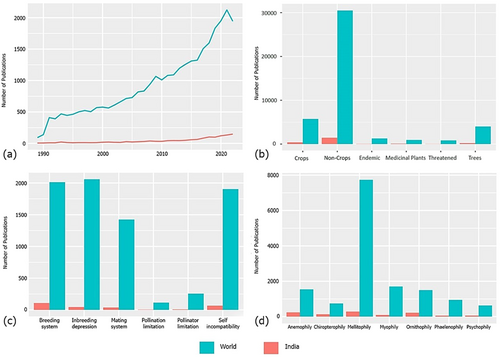
3.2 The present: Why pollination research is important in India
Since 2000, pollination research in India has shown an increasing trend, though studies on bee pollination have only seen a marked increase since 2015 (Figure 2). This rise in bee-related research may be attributed to government policies promoting beekeeping and aforementioned push toward ‘Sweet Revolution’ (a national government initiative aimed at increasing farmers' incomes through scientific beekeeping and the production of honey and associated products) (https://www.indiastat.com/). However, several economically and ecologically important plants are pollinated by other animal groups such as birds (ornithophily), bats (chiropterophily), moths (phalaenophily), flies (myophily) and butterflies (psychophily) (Hill, 1997; Kearns et al., 1998; Klein et al., 2007; Ollerton et al., 2011; Ollerton, 2021; Subramanya and Radhamani, 1993). These alternative vectors are known to legitimately serve more than 70% of the pollinator-dependent angiosperms globally; yet research on these interactions remains scarce compared to melittophily (Rader et al., 2020). To ensure food security, conservation of biodiversity and ecological balance, it is essential to study pollination across all pollinator guilds/syndromes, which should be investigated at broader biological scales, such as communities or biomes.
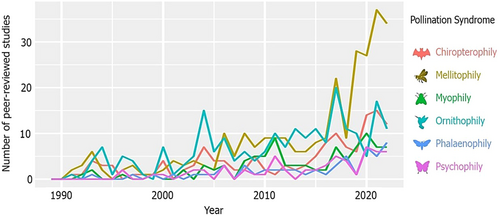
Incorporating ecological elements is crucial for comprehending the reproductive fitness and regenerative capacity of plant species (Barrett, 2010; Ren et al., 2012). Community ecology studies concerning plant interactions with pollinators and antagonists are essential for organized reintroduction of species into fragmented habitats and for setting conservation priorities. Research on functional biology, trade-offs linked to floral resource availability, pollinator ecological niches, pollinator cognitive behaviour and pollination ecotypes plays a pivotal role in our understanding of their eco-evolutionary stability (Mayer et al., 2011). Exploring these adaptations deepens our knowledge of the diverse array of interactions between plants and pollinators and their significance within ecosystems.
The presence of a diverse range of pollinators is of paramount importance for ensuring the stability and resilience of the pollination process. Documenting the diversity and geographical distribution of pollinators across different regions in India would play an essential role in devising strategies to conserve and strengthen their populations (Tandon et al., 2020). India hosts over 700 bee species, with only five classified as social bees (Orr et al., 2021), highlighting the significant untapped potential of alternative pollinators for agricultural benefits. It is essential to gain insights into the habitat and floral preferences of solitary bees, as this knowledge is critical for emulating natural habitats, thereby facilitating the diversification of pollinators within agricultural settings (Shivanna, 2022). Solitary bees are often more effective than honeybees in terms of pollination, as they can adapt to various temperatures and other variables (Vaughan and Black, 2008). Moreover, owing to their solitary behaviour, only a limited number of individuals can oversee the populations of flowering plants and the well-being of both plants and bees relies significantly on the mutualistic interactions they engage in within the plant community (Adit et al., 2022). In an effort to revive declining pollinator diversity, many Western countries are promoting the use of ‘bee-hotels’ and ‘bee-gardens’ which serve as the insect equivalent of birdhouses. These have gained popularity for conserving native bee taxa in both rural and urban environments (Prendergast, 2023). The floral resources, such as flowering strips, wildflower meadows and hedgerows, can also be an efficient approach, as they act as stand-in resources to bridge the gap between successive seasonal crops (Bishop et al., 2022; Osterman, 2022). Some studies show a remarkable increase in crop yield due to increased pollinator assemblage in the agricultural fields adjacent to the forest patch (Aizen and Feinsinger, 2003; Vergara and Badano, 2009). Considering the Indian scenario of agricultural set-up, there are enormous opportunities to harness the synergistic effect of wild pollinators in agricultural zones by creating floral resources and in those near forest patches (Bhattacharya and Basu, 2018). Restoration of fragmented forests can not only improve the diversity of pollinators but also result in enhanced foraging efficiency which have direct consequences on improving fruit and seed production (Blüthgen and Klein, 2011).
3.3 The future: What road should pollination research in India take
Wild pollinators worldwide are encountering numerous challenges, largely due to habitat loss, changes in land-use pattern, heavy use of insecticides and pesticides, shifts in climate, along with other stressors like invasive species and the spread of pests and diseases (Kevan and Viana, 2003; Potts et al., 2010; Vanbergen et al., 2020). Extensive studies carried out globally have highlighted the declining trend in the density and diversity of wild pollinators which also contribute to pollination of wild and crop species (Nath et al., 2023). This has led to deficiency of pollination services leading to the ‘global pollinator crisis’ (Kearns et al., 1998; Tylianakis, 2013).
There is a pressing need to identify pollinator hotspots in India, locations where investing in pollinator conservation will yield the highest returns (such as the Eastern Himalayas, Western Himalayas, Western Ghats, Deccan Plateau and Northeast India). These regions have exceptionally high diversity and endemism of plants and potential pollinators. The affluence of pollinator groups in these hotspots can offer an avenue for identifying alternate pollinators and provide information about pollinator decline, besides helping in making policies related to the conservation of the forest trees and RET (Rare, Endangered and Threatened) species. Due to the rich biodiversity of both plants and pollinators in these regions, sustainable agricultural practices such as agroforestry and buffer plantations also have the potential to yield greater economic returns (Barrios et al., 2018; Udawatta et al., 2021).
Over the past two decades, significant attention has been devoted to climate change and its impact on the altitudinal migration of plant and pollinator species, along with their phenology and pollination process (Bartomeus et al., 2011; Cleland et al., 2007; Settele et al., 2016; Hegland et al., 2009). Nevertheless, in India, there is a notable absence of concrete data on these aspects. While some studies have explored the short- and long-term consequences of climate change on pollinator decline, most lack empirical insights into the intricate relationships between plants and pollinators (Bhatt et al., 2018; Reddy et al., 2013). Furthermore, our understanding of how various drivers of climate change synergistically affect these ecosystem services remains limited. The introduction of invasive plants, which often adapt better to climate fluctuations, poses a significant threat to the well-being of native plants and their pollinators (Giejsztowt et al., 2020). These exotic plants typically propagate through self-pollination and frequently fail to provide appropriate reward to the indigenous floral visitors (Bradley et al., 2009; Giejsztowt et al., 2020). As both climate fluctuations and invasive species threaten pollinator-dependent crops, integrating pollination ecology into climate-smart agricultural practices is essential to ensure global food security (Sharma et al., 2022).
The growing demand for increased food production has led to a substantial rise in the use of chemical pesticides to boost crop yields (Liu et al., 2015). However, this practice has severe negative consequences on the well-being of various pollinator groups and carries serious socioeconomic costs. Numerous studies indicate that these chemical pesticides not only harm bee colonies but also affect wild insect and bird pollinators (Biesmeijer et al., 2006; Sponsler et al., 2019). The primary cause of the widespread decline in bee populations in Europe can be attributed to the utilization of a specific class of pesticides known as neonicotinoids (Auteri et al., 2017). These chemicals can disrupt the cognitive processes of insects and hinder their ability to learn about floral attractants. This can lead to a complete loss of fundamental associations vital for their survival, such as connecting floral scents with food sources (Balbuena et al., 2015; Baron et al., 2017; Belzunces et al., 2012). Consequently, bees perish due to their inability to adequately nourish themselves. India relies heavily on pesticides, with an annual average consumption of 59,876.14 metric tons (2014–2021), which accounts for nearly 2% of the world's pesticide consumption (https://www.indiastat.com/; Zhang, 2018). Out of 293 pesticides registered in India 130 are considered hazardous by World Health Organization (Pandey, 2023; Soman et al., 2024). There are no studies on the impact of these pesticides on pollinators. Research into the effects of these chemicals on pollinator health would contribute to the development of integrated pest management policies and alternative solutions. Such strategies would help to conserve pollinators without compromising crop yields. The increasing use of biopesticides is a promising trend in India (Chakraborty et al., 2023). The average annual consumption is currently at 7110.71 metric tons (2014–21) and shows a steady increase over the years (Figure 3). Gradual transition to integrated pest management and biopesticides can reduce our dependence on chemical pesticides. This shift has the potential to substantially combat the pollinator decline and, in the long run, enhance crop production by harnessing the full benefits of this mutually beneficial ecosystem service (Tripathi et al., 2020).
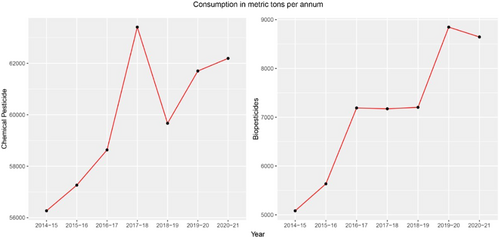
The impact of plant-pollinator interactions is huge in terms of their economic value (Potts et al., 2016). Several authors have shown the importance and role of pollinators in terms of ecosystem services and economic value (Potts et al., 2011). It is estimated that the direct contribution of insect pollination to Indian agriculture is substantial, amounting to US$22.5 billion, which constitutes 8.72% of the total value of agriculture annually (Chaudhary and Chand, 2017). Data for six fully or partially pollinator-dependent crops in India demonstrates the substantial economic value of pollinator services per hectare (Table 1). The greater a crop's dependence on pollinators, the higher the economic potential of the pollinators.
| Crop | Yield (kg/Hectare) | Price (MSP in Rs/kg) | Pollinator dependence | Pollinator dependence rate | EVp (Rs/Hectare) |
|---|---|---|---|---|---|
| Cicer arietinum (Gram) | 1019.50 | 38.25 | High | 0.65 | 25347.31 |
| Cajanus cajan (Tur/Arhar) | 793.33 | 48.00 | Moderate | 0.25 | 9520.00 |
| Brassica napus (Rapeseed) | 1304.75 | 35.72 | High | 0.65 | 30301.45 |
| Helianthus annuus (Sunflower) | 773 | 42.57 | Moderate | 0.25 | 8227.29 |
| Gossypium spp. (Cotton) | 462.25 | 44.73 | High | 0.65 | 13440.69 |
| Theobroma cacao (Cacao) | 669 | 181.85 | Essential/obligate | 0.95 | 115579.31 |
CONCLUSIONS
Pollination studies play a key role in illuminating the underlying causes for effective mitigation of the decline of both flowering plants and pollinators (Burkle et al., 2013). The knowledge gathered on this crucial ecosystem service will constructively contribute to the achievement of sustainable future goals. India is characterized by its rich biodiversity; and as a habitat for numerous endemic and endangered species, it offers substantial research prospects in this field. However, the bulk of existing data lacks a clear focus and direction due to the scarcity of research groups engaged in such studies. This gap in the flow of knowledge is conspicuously reflected in the analysis of the limited contribution by the scientific community in the published research on pollination in the country. While there is a growing emphasis on adopting a community network approach to address fundamental issues, challenges such as insufficient funding, waning interest among young researchers in field-based studies, non-collaborative research environment and lack of awareness continue to impede progress in this critical area. As pointed out in this review, there are several key facets that can contribute to the expansion of our conceptual knowledge of the subject, while also offering a framework for formulating effective policies aimed at conservation and sustainable development (Table 2, Figure 4). Native bees (including stingless bees) have fidelity to local flora (developed through years of co-evolution) and are highly efficient pollinators for wild plants as well as crop species in the country (Abrol, 2012). Due to their floral constancy and polylactic foraging habits, they are potentially important to boost crop yields through pollination (Chauhan et al., 2019; Layek et al., 2021, 2022; Tej et al., 2017). Ex situ conservation of native pollinators is an entrepreneurial opportunity, has been so far, ignored and underappreciated in India, and is thus important to acquire an ecology–economy (eco–eco) balance.
| Major topics | Future directions | Outcomes |
|---|---|---|
| Reproductive biology/ecology of plants | In-depth investigations into the structural and functional aspects of plant reproductive traits in wild and crop species. | Identification of limitations affecting plant reproduction. |
| Ecological adaptations | Examining ecological and evolutionary adaptations to shared pollinators among co-flowering, sympatric species or specific pollinator in specialized Plant species | Facilitates understanding of both micro- (adaptations) and macro- (speciation) evolutionary trends driven by pollinators. |
| Plant-pollinator interaction webs | Community ecology to understand fundamental patterns and processes that govern ecosystem functioning and impacts of climate change and habitat destruction. | Helps in developing conservation approaches and sustainable restoration and management of disturbed habitats. |
| Trade-offs between floral resources and floral visitors | Investigating trade-offs in phenotypic traits resulting from selection pressures exerted by pollinators and floral antagonists (such as pollen/nectar robbers or florivores). Studying evolution of traits of pollination ecotypes and congenerics. | Valuable for gaining insights into the evolutionary forces that shape plant traits and also for optimizing crop production through the manipulation of these traits. Provides valuable insights in making conservation strategies for plants growing in ecologically sensitive habitats. |
| Database/documentation for density and diversity of pollinator and dependent plant species in different habitats | Help in identifying pollinator hotspots and in understanding key factors determining pollinator abundance and their distribution. | Provides baseline data for future evaluation of the decline of pollinators and plants. Helps in understanding environmental requirements of specific pollinators and plant species. |
| Land-use management | Empirical quantification of crop productivity in agricultural ecosystem adjacent to forest patches and other green areas. | Helps in the formulation of policies that optimize agricultural yield through effective land utilization. |
| Pollinator health | Exploring various environmental factors, particularly of various pesticides, pollutants on pollinator health, and their efficacy in pollination. | Helps in developing suitable policies on the use of various pesticides to minimize their effects on non-target organisms such as pollinators. |
| Effects of climate change | Determining the consequences of climate change on spatial and phenological shift of pollinator and plant species. Impact on the availability of pollinators in synchrony with flowering of specific plant species. Cumulative impact influencing plant and pollinator fitness. | Help in developing mitigating impacts of climate change on pollinators and plant species. Also, it helps in identifying effective indicator species to monitor climate fluctuations. |
| Role of wild pollinators besides managed bees in the sustenance of wild plant species and crop yield. | Identifying different pollination services and their cost valuation by wild and unconventional pollinators besides honeybees. | It enables farmers to diversify crop systems to reduce reliance on a single pollinator group (e.g., honeybees). It can serve as an “insurance” against disruptions in specific pollinator populations. |
| Technological advances | Utilizing cutting-edge technologies like DNA metabarcoding, remote sensing, spectral and scent analysis, artificial intelligence and automated tracking systems to manipulate pollinator behaviour, their floral preferences and network dynamics and floral traits. Exploring the feasibility of alternative pollination approaches such as developing pollinator drones or robots. | Facilitate manipulation of pollination services to suit crop species and in the conservation of endemic and endangered species. |
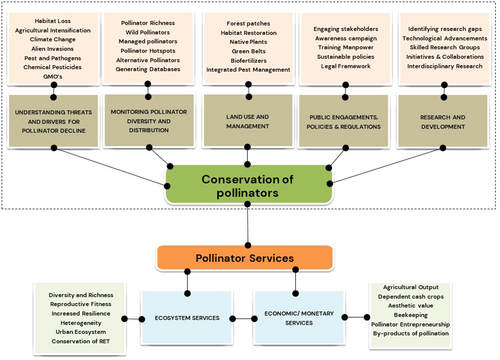
There is a lack of public awareness and education regarding the importance of pollinators and their role in maintaining ecosystem health and food security, making it difficult to build support for conservation efforts (Belzunces et al., 2012). Although abundant populations of native honeybees (Apis cerana) exist throughout the country, farmers and beekeepers continue to rear Apis mellifera, an introduced exotic species, for farm management and honey collection (Abrol et al., 2015). It is imperative to promote native bees, not only for agricultural gains but also for their vital role in the sustainability of native plant species (Kevan et al., 1990; Requier et al., 2019; Reilly et al., 2020). This can be accomplished by designating these groups as national treasures along with public beekeeping enterprises. Regular awareness and training campaigns, conducted in both urban and rural areas, advocating for pollinator-friendly initiatives such as the cultivation of native flora, establishment of pollinator gardens and the installation of bee hotels, can prove highly effective in achieving this goal (Shi et al., 2024). There exists a potential for a more extensive collaborative effort in terms of pollinator initiative, focused on the distinct requirements of the Indian subcontinent's biodiversity. This offers an avenue for sharing data and resources, encompassing not only cultivated crops but also indigenous plant species. Such collaboration lays the groundwork for the development of conservation policies that prioritize the well-being of pollinators (Zhang, 2018) (Figure 4). One of the advantages of taking up studies on pollinators and pollination is that it does not require expensive infrastructure or instrumentation. Relevant studies can be carried out largely in the field with some training. It would be useful to conduct integrated workshops in post-graduate colleges to attract young students to take up research in this field and translate it appropriately at the grassroot level.
AUTHOR CONTRIBUTIONS
Arjun Adit: Conceptualization; data curation; formal analysis; methodology; visualization; writing—original draft. Vineet Kumar Singh: Conceptualization; data curation; formal analysis; methodology; visualization; writing—original draft. Rajesh Tandon: Conceptualization; resources; supervision; validation; visualization; writing—review and editing. Kundaranahalli Ramalingaiah Shivanna: Validation; visualization; writing—review and editing.
ACKNOWLEDGEMENTS
We acknowledge the University of Delhi for research facilities and the Institution of Eminence for financial assistance (Grant no: IoE/2023-24/12/FRP to RT).
CONFLICT OF INTEREST STATEMENT
The authors declare no conflicts of interest.
Open Research
DATA AVAILABILITY STATEMENT
All data generated during the study is included in the manuscript.



